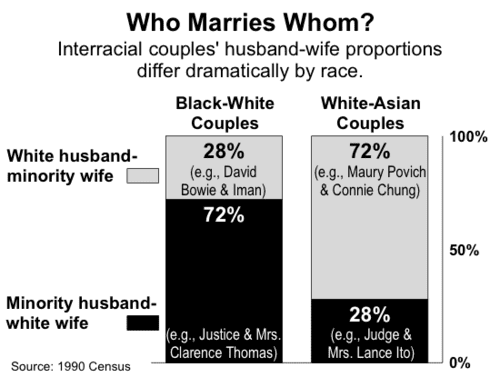


By Steve Sailer
05/19/2017

A graph from my 1997 NR article: “Is Love Colorblind?”
From the San Francisco Chronicle, 20 years after my “Is Love Colorblind?” article in National Review:
As intermarriage spreads, fault lines are exposed
By Jill Tucker May 18, 2017 Updated: May 19, 2017 1:03pm
The growth of interracial marriage in the 50 years since the Supreme Court legalized it across the nation has been steady, but stark disparities remain that influence who is getting hitched and who supports the nuptials, according to a major study released Thursday. …
Among the most striking findings was that black men are twice as likely to intermarry as black women — a gender split that reversed for Asian and Pacific Islander Americans and, to researchers, underscores the grip of deeply rooted societal stereotypes.
The comprehensive study was released by the Pew Research Center to mark a half-century since the nation’s high court, in Loving vs. Virginia, invalidated antimiscegenation laws that had remained in more than a dozen states. … Overall, roughly 17 percent of people who were in their first year of marriage in 2015 had crossed racial or ethnic lines, up from 3 percent in 1967.
But much of that was driven by demographic change: America was basically a black and white country in 1967 (as well as, perhaps, administrative changes: Hispanics and South Asians were officially white until later).
It’s worth noting that the big growth in propensity toward intermarriage happened a long time ago. A recent study estimated that the propensity toward interracial marriage among people under 35 was 72% as large as it is today by 1980, which was a long time ago.
Across the country, 10 percent of all married couples — about 11 million people — were wed to someone of a different race or ethnicity as of 2015, with the most common pairing a Hispanic husband and a white wife.
That hasn’t been common in the media, however, since I Love Lucy went off the air.
Both changes in social norms and raw demographics have contributed to the increase in intermarriages, with Asians, Pacific Islanders and Hispanics — the groups most likely to marry someone of another race or ethnicity — making up a greater part of the U.S. population in recent decades, according to the report.
Meanwhile, public opinion has shifted toward acceptance, with the most dramatic change seen in the number of non-blacks who say they would oppose a close relative marrying a black person. In 2016, 14 percent of whites, Hispanics and Asian Americans polled said they would oppose such a marriage, down from 63 percent in 1990.
Rates of intermarriage vary in many ways — by race, age, gender, geography, political affiliation and education level. And the differences can be pronounced.
Among newlyweds, for example, 24 percent of African American men are marrying someone of a different race or ethnicity, compared with 12 percent of black women. While the overall intermarriage rates have increased for blacks of each gender, the gap between genders is “long-standing,” the Pew researchers said.
This gender disparity is reversed for Asian and Pacific Islanders, with 21 percent of recently married men in mixed unions, compared with 36 percent of women.
The gender gap tends to be bigger among Asian immigrants than among Asians born in this country.
Why such differences exist is not entirely understood.
“There’s no clear answer in my view,” said Jennifer Lee, a sociology professor at UC Irvine and an expert in immigration and race. “What I suspect is happening are Western ideals about what feminity [sic] is and what masculinity is.”
It’s funny how Asians and blacks have no agency. Only white people matter to sociologists.
She noted that not all intermarriages are viewed equally — and never have been.
“We’re more likely to view Asian and Hispanic and white as intercultural marriages — they see themselves crossing a cultural barrier more so than a racial barrier,” she said. But a marriage between a black person and a white person crosses a racial color line, “a much more difficult line to cross.”
Notably, a recent Pew survey found that African Americans were more likely than whites or Hispanics to say that interracial marriage was generally a bad thing for society, with 18 percent expressing that view.
It can be seen as “leaving” the community, said Ericka Dennis of Foster City, who is black and has been married for 20 years to her husband, Mike, who is white.